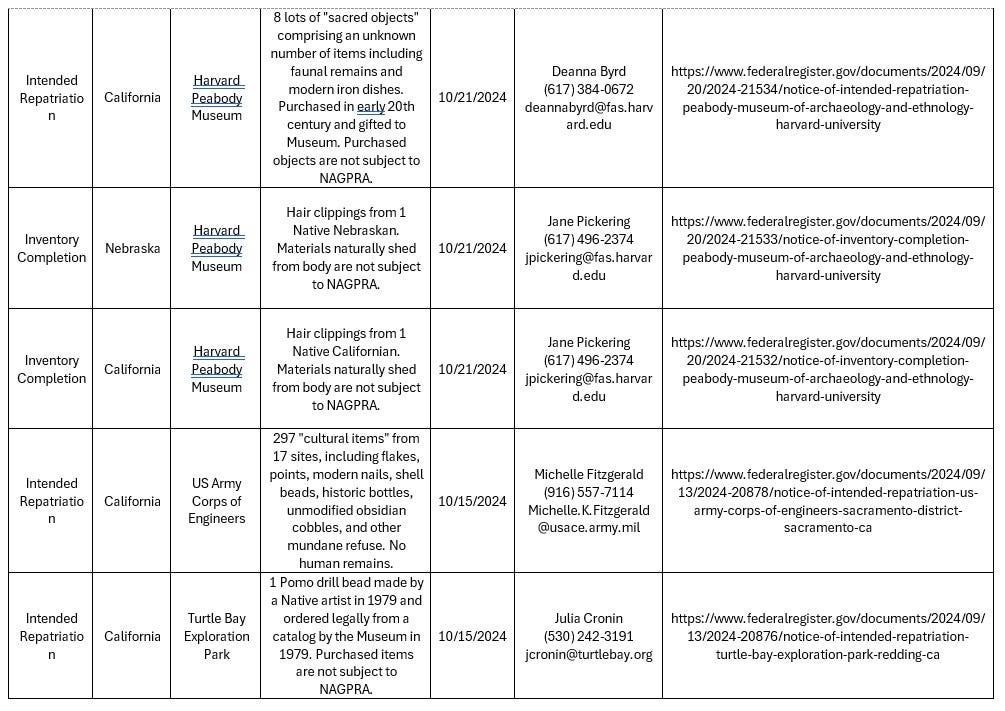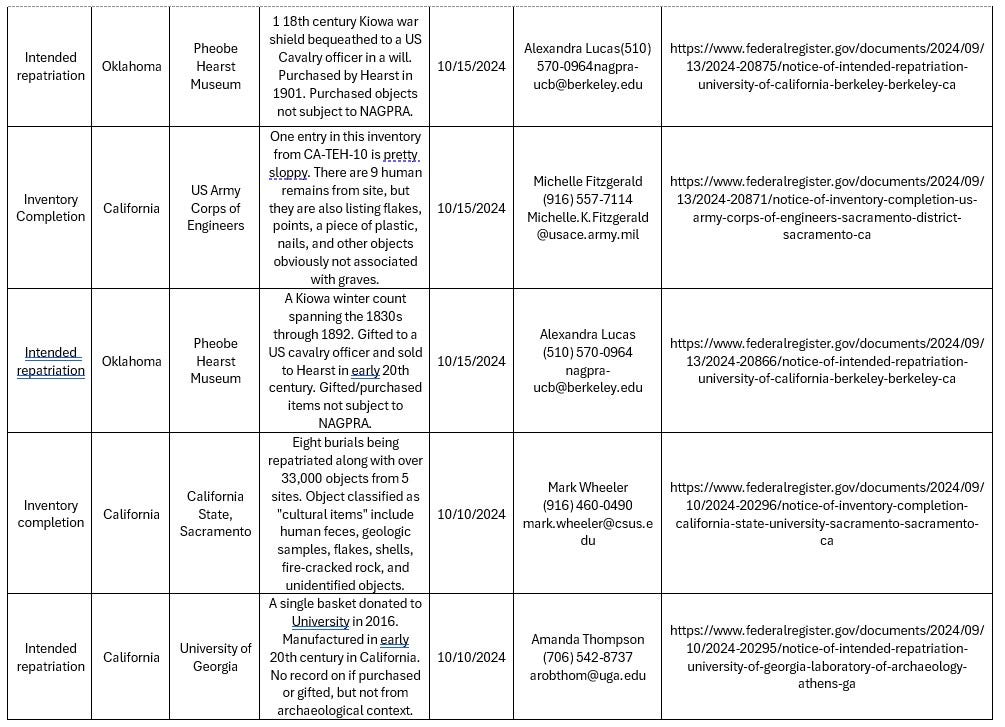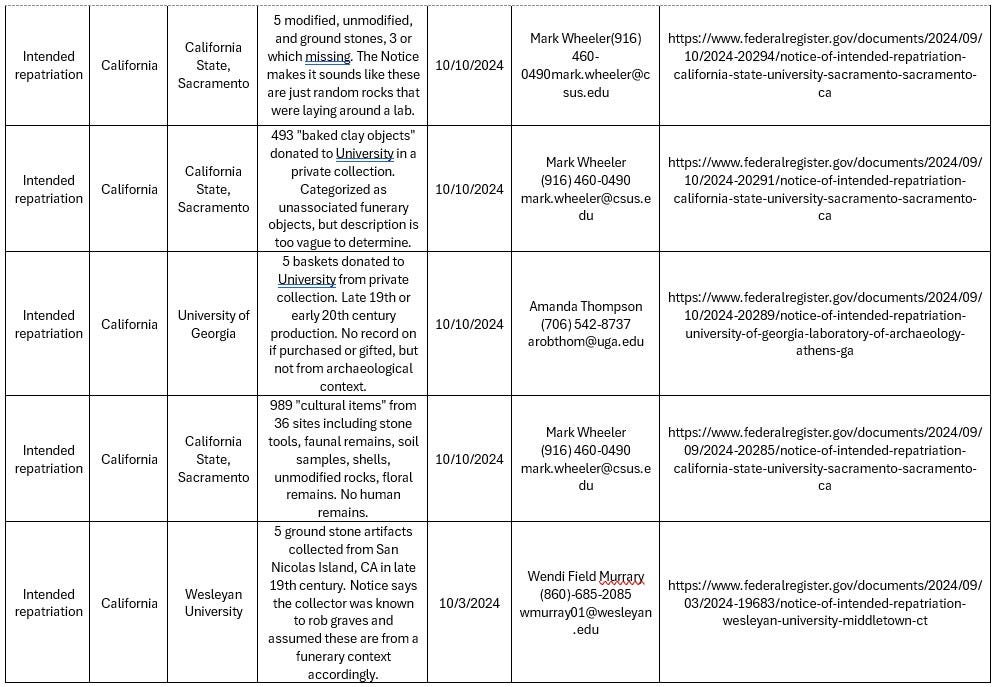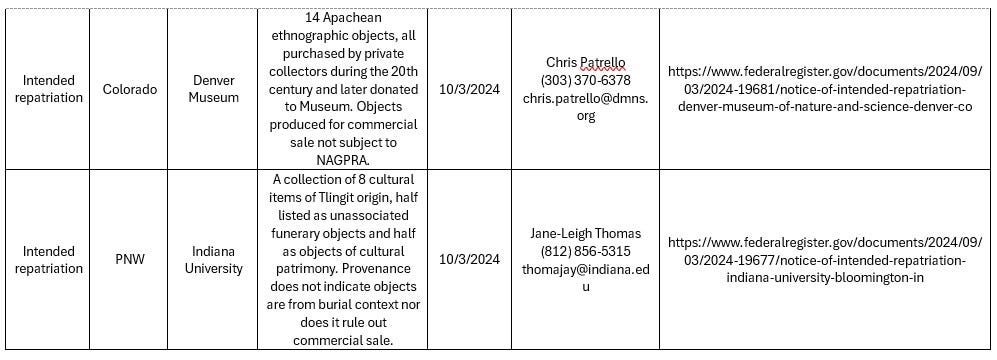Saving Mummy Cave
NAGPRA Notes No. 1
One of the first things I wrote for this newsletter discussed the controversial repatriation of items from Mummy Cave, a deeply stratified rock shelter in northwest Wyoming. If you haven’t aleady, I would recommend going back to read it. The U.S. Forest Service intended at the time to repatriate the entirety of Mummy Cave’s Level 36, a notably rich deposit of 1500 year old artifacts and features that contained basketry, cordage, footwear, animal bone, stone tools, and of course, a mummy. That mummy, affectionately named Mummy Joe, was a naturally dessicated body buried in a stone-lined crypt at the back of the rockshelter in a sheep-skin robe and nothing else. So when the Forest Service proposed reptriating the ENTIRE contents of Level 36 along with Mummy Joe, it raised eyebrows, inspired a FOIA request, led to the creation of this newsletter, and now here we are today, in a far different repatriation landscape than the fall of 2022. Here, I’d like to reflect on the Mummy Cave case in light of subsequent events and introduce a new series called NAGPRA Notes.
Media Matters
When I published Losing Mummy Cave in February 2023, it kind of went viral thanks to the efforts of a few concerned community members that spread it on social media and through professional listservs. To this day, it remains my most read post. People in Wyoming, archaeologists and public alike, very much care about the fate of Mummy Cave.
Shortly after publication, a local media outlet put two and two together, figured out who I am, and reached out for comment. I was happy to chat. The reporter was thoughtful and open-minded about the issue, and he intended to do a long-form piece about repatriation with Mummy Cave as its center-piece. Before we finished chatting, I encouraged him to reach out to the Forest Service and the Tribes involved for their take on the matter, which was surely very different than mine. I emphasized how complicated and sensitive the issue can be and imparted that I’d be interested in hearing a different point of view.
Several weeks passed with no news article, so I reached back out. In the intervening time the reporter obtained comments from the Forest Service and had spoken to a member of the Shoshone-Bannock Tribe about the case. Reportedly, the conversation with the Shoshone-Bannock was contentious, ending with the ominous admonition of “I’d better not see my name in your newspaper.” To this day, there has been no popular media reporting on Mummy Cave. I don’t blame them. Local news outlets in Wyoming most often report on community events and bar fights. Wading into the repatriation debate is a bit out of scope.
Rescinded
In the end, the coverage ended up paying off. On August 6th, 2024, the U.S. Forest Service rescinded their Corrected Notice of Inventory Completion for Mummy Cave, removing the entirety of Level 36 from consideration for repatriation. Staffing changes between 2018 and 2022 seem to have made a big difference. The former Forest Supervisor relocated to a different office and the regional NAGPRA coordinator that orchestrated the repatriation moved on to a position in Washington D.C. (of course). I am grateful to those new staff who listened and responded thoughtfully to our concerns.
A first lesson learned from Mummy Cave is that staffing matters. Although the Federal government must maintain the affectations of indifference, functioning only by the edicts of their administrative procedures, it is ultimately comprised of individuals, each of whom enters their position with their own biases and political motivations. A few activist-minded government employees can wreak havoc on resource management decisions should they be allowed into positions of power. Those people, guided by personal politics rather than public service, should probably be running credit cards at a fee booth rather than deciding the fate of the archaeological reord.
But it’s not all roses. The Forest Service rescinded the 2022 Notice, but they also listed a revised Notice of Inventory Completion listing 226 objects identified during initial consultation on Mummy Cave. These objects were identified by one of the consulting Tribes as unassociated funerary objects, and their inclusion in the updated inventory was described to me a compromise between the initial inventory and the (in my mind) accurate one, which includes only Mummy Joe and his sheep skin blanket. So we’ll likely still lose some of Mummy Cave that shouldn’t be lost. But it’s much better than it was when we started this, and I consider that a partial victory.
Everything Back
A common response I get from archaeologists who object to my view that flakes, animal bones, stone tools, charcoal, and human feces shouldn’t be subject to NAGPRA goes something like this: “It’s not for you to decide what is and is not a funerary or sacred object. The Tribes know things about their own culture that you do not.” I have no doubt that’s partially true. Anthropology has built a robust corpus of knowledge regarding human cultures globally, but it is by no means comprehensive. Surely, there are some meaningful objects (i.e., “cultural items”) that have escaped the volumes of ethnographies and archaeological reports that the discipline has amassed over the last 150 years.
But I’m not willing to sell our craft so short. We know alot about human culture, what is sacred and profane. And ultimately, we also know from correspondence obtained as part of the Mummy Cave inquiry that those decisions can be arbitrary, at best. In fact, much of the unredacted correspondence from our FOIA request relates to figuring out which items, exactly, are funerary objects and which are not. Nobody could seem to agree, and it’s no wonder why. None of the correspondence indicates that anybody considered the contexts from which the Mummy Cave artifacts were recovered, whether a burial or otherwise. I admit that I too would have a hard time picking up an arrowhead and deciding if it came from a botched hunt or a burial based on its physical attributes alone. They look identical. That’s why, in the end, the small group of people handling the repatriation just threw the whole level in for reptriation. It’s certainly easier than reading the report.
Mummy Cave Everywhere
Here’s a fun exercise. Go to federalregister.gov and type in the search term “NAGPRA debitage” to find all the NAGPRA inventories and repatriation notices that list chipped stone refuse. As of September, 2024, I got 224. “NAGPRA flake” returns even more, with 753. “NAGPRA charcoal” returns 454. “NAGPRA” alone returns 5,400. You get the point. A process intended to return human burials is now commonly used to return much of the archaeological record. Here’s a good example from a military base in Missouri:
Based on the information available, human remains representing, at least, four individuals have been reasonably identified. The 40,501 funerary objects include 9,606 debitage, 109 utilized debitage, 112 bifaces, 51 hafted bifaces, two axes, 34 cores, 12 uniface tools, one drill, one hammerstone, 30 hematite, 41 unmodified stones, one lithic tool, 142 body sherds, five rim sherds, one lot of body sherds, two lots of shell, 70 shell fragments, four lots of animal bone, 30,242 animal bone fragments, five soil samples, six floatation samples, two ochre, one lot of charcoal, two lots of seeds/nutshells, five misc. metal, eight glass fragments, five pieces of modern wood, and one shoe string.
The pottery sherds? Maybe. Pots are sometimes buried with people. But the modern metal, glass, wood, and shoestring? That makes me suspect there wasn’t a great deal of thought attending this NAGPRA inventory. It’s the same way Mummy Cave was handled on a more egregious scale. If you don’t want to do the work of determining accurately which artifacts are subject to repatriation, or of having the difficult task of saying “no” to a Tribal consultant with whom you’ve earned trust, then you just repatriate the entire site. It’s less work for the Federal agencies and many activists are happy to vindicate perceived harm by archaeologists in this way.
I wasn’t fully aware of how extensive this pratice would become when I wrote Losing Mummy Cave. I suspected that the New Rules might have some big impacts on how archaeologists did their jobs, but I assumed that more in the archaeological community would object to abuses of the Law of this sort. As more and more archaeological assemblages are listed for repatriation, it is increasingly obvious that assumption was naiive.
A Way Forward
Of all the lessons learned from Mummy Cave, there’s two that stick out as most important: stay engaged and speak up. Very few people take the time to peruse the Federal Register alongside their morning coffee. Reading about the innerworkings of the administrative State is nobody’s idea of a good time. But that’s where NAGPRA happens. There’s typically a 30-day window before action can be taken on Register notices, so everyone invested in archaeological preservation should be searching federalregister.gov on at least a monthly basis for Notices that impact their region of interest. Nobody is going to do it for you.
And when you find something that looks off, speak up. The long process of repatriation takes place within an ideological bubble between Federal agencies, Museums, Tribes, and private sector consultants, none of whom are incentivized to represent the interests of archaeological preservation. Federal Agencies want to protect their relationships with Tribes at all costs, Tribes want to assert their agency in every way possible, and consultants need to get paid. Every Notice is listed with a contact to whom questions can be directed. Do your research, mobilize your colleagues in Departments or Professional Societies, and draft letters expressing your concerns. Find their boss and cc them as well. In my experience, many of those contacts are concerned for archaeological preservation as well, but their hands are tied by forces beyond their control. As Mummy Cave has shown, a little pushback can go a long way.
NAGPRA Notes
In this spirit, I’ll periodically be releasing a new series of newsletters called NAGPRA Notes in which I compile and summarize concerning NAGPRA lsitings from the Federal Register. I’ll focus on listings that are especially egregious violations of NAGPRA’s intent, those that contain routine archaeological refuse or legally purchased Indian crafts rather than human remains and burial objects. I’ll write a summary of the listing, list the contact information, and maybe even later draft a letter template for use by those who want to reach out about the listing. My first compilation of entries is below.
Combing through NAGPRA entries systematically has been enlightening. There are still important NAGPRA repatriations through which burials and funerary objects of unambiguous cultural affiliation are being returned. For example, Texas Tech University is currently repatriating several richly-endowed 19th century Comanche burials looted from private lands and later donated to the Museum. Work like this is what NAGPRA should be about. Other notices? Not so much. Of 62 NAGPRA entries in the last month, I think around 22 are marginally legal, some worse than others. These range from the repatriation of entire archaeological assemblages that contain no human remains to a commercially purchased bead, literally made and sold in a catalog in 1979. Both, of course, from California.
But look for yourself. I’ve compiled everything into a Table below. Let me know if I’m missing any key context or can clarify in any way. And pick up the phone to call one of these contacts if the mood strikes. Be nice, ask questions, and let me know what you hear. This whole mess isn’t going to get better unless we can start having open conversations about it.







I have a very similar article coming out in Minding the Campus! It's about absurd repatriation decisions -- from fossilized feces to works of art!
Good work Spencer and Elizabeth! If y'all don't protect the past who will